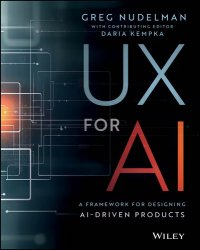UX for AI: A Framework for Designing AI-Driven Products
- Добавил: literator
- Дата: 10-05-2025, 22:05
- Комментариев: 0
 Название: UX for AI: A Framework for Designing AI-Driven Products
Название: UX for AI: A Framework for Designing AI-Driven ProductsАвтор: Greg Nudelman, Daria Kempka
Издательство: Wiley
Год: 2025
Страниц: 352
Язык: английский
Формат: True EPUB (Retail Copy)
Размер: 120.8 MB
Learn to research, plan, design, and test the UX of AI-powered products.
Unlock the future of design with UX for AI—your indispensable guide to not only surviving but thriving in a world powered by artificial intelligence. Whether you're a seasoned UX designer or a budding design student, this book offers a lifeline for navigating the new normal, ensuring you stay relevant, valuable, and indispensable to your organization.
In UX for AI: A Framework for Designing AI-Driven Products, Greg Nudelman—a seasoned UX designer and AI strategist—delivers a battle-tested framework that helps you keep your edge, thrive in your design job, and seize the opportunities AI brings to the table. Drawing on insights from 35 real-world AI projects and acknowledging the hard truth that 85% of AI initiatives fail, this book equips you with the practical skills you need to reverse those odds.
You'll gain powerful tools to research, plan, design, and test user experiences that seamlessly integrate human-AI interactions. From practical design techniques to proven user research methods, this is the essential guide for anyone determined to create AI products that not only succeed but set new standards of value and impact.
Users increasingly expect modern software applications to deliver intelligent behaviors above and beyond basic functionality. The subjective difference between the delight of using an app that magically recommends what you might want to watch, eat, or purchase versus one where you have to laboriously specify your desires can be huge. If you aren’t willing to invest in making that happen, your competitors surely are. In practice, this magic is delivered via Machine Learning (ML) or Artificial Intelligence (AI) techniques. The purely technical aspects of these systems form a fascinating and fast-moving field in their own right. Still, here, we will focus on the product design and User Experience (UX) implications of these technologies. How can we integrate AI/ML capabilities into a product experience in such a way that the risks and challenges are minimized while our users reap the maximum benefits?
Some advantages of AI/ML are its ability to provide answers to problems for which it is difficult or impossible to hand-craft “classic” software solutions and to deal with intrinsically noisy or probabilistic domains. Consider the problem of handwritten digit recognition; in the absence of AI/ML, one would likely write a bunch of strange overlapping rules, essentially reinventing the AI/ML approach poorly. One major downside of AI/ML approaches, especially from an experience perspective, is the lack of determinism or calibration in its outputs. By determinism, we mean that, for any given input, the quality of the resulting output cannot be known in advance. For a given user interaction, the result may be good or bad, but we generally do not know for sure which it will be until we generate the result, and we cannot drive the probability of bad results down to zero. By calibration, we mean that, by default, the system itself is often unable to detect or qualify the confidence in the result. That is, it does not “know” whether or not its output is good and may be “confidently wrong.” Therefore, the fun part for system designers is to consider how we might try to build reliable and consistent user experiences atop unreliable and inconsistent foundations.
Inside the book:
• Hands-on exercises: Build your confidence and skills with practice UX design tasks like Digital Twin and Value Matrix, which you can immediately apply to your own AI projects.
• Common AI patterns and best practices: Explore design strategies for LLMs (Large Language Models), search engines, copilots, and more.
• Proven user research strategies: Learn how to uncover user needs and behaviors in this brave new world of AI-powered design.
• Real-world case studies: See how simple, practical UX approaches have prevented multimillion-dollar failures and unlocked unprecedented value.
Perfect for any UX designer working with AI-enabled and AI-driven products, UX for AI is also a must-read resource for designers-in-training and design students with an interest in artificial intelligence and contemporary design.
Скачать UX for AI: A Framework for Designing AI-Driven Products
[related-news] [/related-news]
Внимание
Уважаемый посетитель, Вы зашли на сайт как незарегистрированный пользователь.
Мы рекомендуем Вам зарегистрироваться либо войти на сайт под своим именем.
Уважаемый посетитель, Вы зашли на сайт как незарегистрированный пользователь.
Мы рекомендуем Вам зарегистрироваться либо войти на сайт под своим именем.
